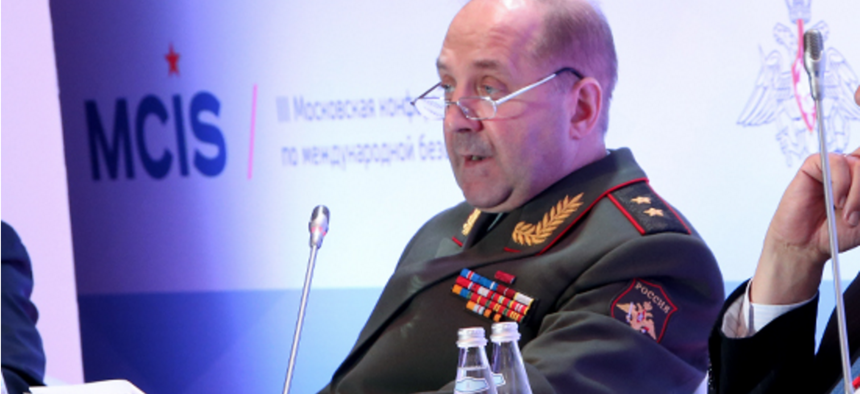
Then-Lt. Gen. Igor Sergun speaks at a conference on international security in Moscow in 2014. Russian Ministry of Defense
Death of the GRU Commander
An American general remembers Russia's complex military intelligence chief, who shaped the Ukraine incursion — and worked hard to bridge the East-West gap.
In February 2014, contact ceased between U.S. and Russian military intelligence as part of an overall shutdown of defense relations in the wake of Russia’s illegal annexation of Crimea. It was the right policy move at the time, but it’s time to get U.S. and Russian military leaders, including intelligence officials, talking to each other again.
One unlikely and subtle advocate of the value of personal communications was the chief of Russian military intelligence, Igor Sergun, who died suddenly on Jan. 3 of a probable heart attack. Recently promoted to Colonel General, Sergun was only 58 years old, young even for an overworked, highly stressed Russian male. An experienced special operations veteran who made his name in the restive Northern Caucasus, Sergun became GRU chief in 2011, later becoming one of the troublingly imaginative architects of Russia’s hybrid, proxy aggression in Ukraine.
I’m frankly unsure how to feel about his death. As a career U.S. Army military intelligence officer, and our senior military attaché to Russia from 2012 to 2014, I met with General Sergun and his staff several times for extended periods. I found him soft-spoken, unassuming, complex, erudite and nuanced. And I learned that even as Sergun relentlessly directed global intelligence operations against our interests, he — paradoxically — also viewed constant confrontation with the U.S. and West as not in Russia’s best long-term interest.
Before U.S.–Russia relations collapsed, Sergun facilitated increased contact between our countries’ military intelligence leaders. During 2012-13, I watched as U.S. and Russian intelligence chiefs from strategic regional and global commands discreetly met in cities across Russia: Khabarovsk in the east, Rostov in the south, and also Sochi, just before the 2014 Winter Olympics. These meetings — which were often the first face-to-face interactions between these senior U.S. and Russian MI officers — always entailed straightforward, cordially hardnosed discussions that intelligence officers understood from a world of black and gray, and rarely white, as traditional adversaries, often foes. Clearly, both sides entered cautiously, but increasingly saw substantive talks emerge on carefully cleared topics.
Never lost or conceded was our unwavering support for our allies, and partners such as Ukraine, who ideally should want us to engage with Russia. But such meetings were invaluable opportunities for both sides to explain why they disagreed on issues such as Syria, the Arab Spring, missile defense and Ukraine. Consequently both sides began to discover issues on which we did agree: radical Sunni Islam, the need for a stable Afghanistan and Central Asia, global terrorism, looming demographic challenges, and future global resource competition.
Perhaps the highest-profile visit came in June 2013, when Sergun invited Lt. Gen. Michael Flynn, director of the Defense Intelligence Agency, for a three-day visit to Moscow. Following a trail carefully blazed by several predecessors, Flynn laid a wreath at Russia’s Tomb of the Unknown Soldier and visited the GRU’s ultra-modern headquarters outside Moscow. There he gave a unique hour-long address on leadership and intelligence to a conference room full of young GRU officers who, judging by their questions, clearly had never before encountered an American intelligence general.
Finally, Flynn hosted an unprecedented dinner for his counterpart in my residence at the U.S. Embassy. The GRU director arrived with two generals and an interpreter. It must have been bemusing for them to go through U.S. Embassy security onto U.S. soil for the first time. Always inquisitive, Sergun showed particular interest in a colorful Leroy Neiman print titled “Red Square.” The customary toasts were hoisted, though Sergun himself was a modest drinker. The last toast called for making “the airlocks fit,” an allusion to the extraordinary Apollo–Soyuz link-up in 1975 during the heart of the Cold War, and an allegory for improving relations. He liked that. All departed with U.S. Embassy baseball caps for their children. The following night Sergun hosted our U.S. delegation at the venerable Sovietsky Hotel, where he gave us a personal tour of Stalin’s time-warped suite upstairs.
General Sergun clearly placed a high value on these exchanges, which showed his desire to do more than simply learn about our military capabilities and intent. If I were Russian, obsessed by real and perceived existential threat, uneasy about the viability of my vast northern nation of demographically challenged citizens, I would be seriously worried. I believe these next-generation geostrategic concerns helped drive Sergun and other senior leaders toward these engagements with us.
My last contact with Sergun occurred in late 2013, just months before relations broke. I requested a meeting to deliver a message, and this powerful intelligence general arrived in short notice in modest street clothes. He took my message and we talked briefly about a planned visit to the United States with some of his senior GRU officers. That idea, of course, went stillborn when Russia invaded Crimea.
So where do we go from here? The status quo, despite some minor improvement, remains quite negative. We must find meaningful ways to talk and work with Russian military counterparts on geo-strategic concerns of mutual interest, of which there are plenty. Despite disagreements and frustrating disinformation, we must persist in this. Nations, especially ones that are traditional confrontational competitors that can existentially threaten each other, must constantly and intensively communicate via different channels and echelons, including sensitive military and intelligence conduits. This is hardly weakness or supplication; rather it displays strength, confidence and prudence, and it shows we are comfortable in our own skin.
Certainly we collectively can learn that much from the complex Colonel General Sergun.
NEXT STORY: The Americans Who Volunteer to Fight ISIS



